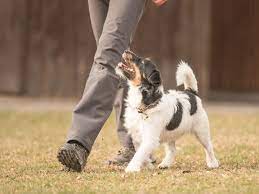In the realm of pet ownership, the connection between humans and dogs stands unparalleled. Dogs, known as man’s best friend, not only provide companionship but also offer unwavering loyalty and love. To cultivate a harmonious relationship with your furry companion, investing time and effort in proper dog training is essential. This comprehensive guide will take you through the fundamental aspects of dog training, providing insights, tips, and techniques to help you build a strong and lifelong bond with your canine friend.
Understanding the Basics of Dog Training
- The Importance of Training for Dogs: A Foundation for a Harmonious Relationship
Before delving into specific training techniques, it’s crucial to understand why training is essential for dogs. Proper training serves as the foundation for a harmonious coexistence, ensuring a well-behaved and socially adaptable pet. A trained dog not only obeys commands but also exhibits good manners, making them a joy to be around.
- The Psychology of Dogs: Unraveling Canine Behavior
To effectively train a dog, it’s imperative to comprehend their psychology. Dogs are pack animals, instinctively seeking leadership and structure. Understanding canine behavior, such as body language and communication signals, allows you to connect with your dog on a deeper level, fostering a more effective training experience.
Training Techniques for a Well-Behaved Dog
- Basic Commands Every Dog Should Know: Building a Strong Foundation
- Sit, Stay, and Come: The Core Commands Teaching your dog basic commands like sit, stay, and come lays the groundwork for more advanced training. These commands enhance your dog’s responsiveness and create a sense of discipline.
- Leash Training: Mastering the Art of Walks Leash training is crucial for both the dog’s safety and the owner’s control. Teaching your dog to walk calmly on a leash prevents pulling and promotes a more enjoyable and stress-free walking experience.
- Positive Reinforcement: The Key to Effective Training
- Reward-Based Training: Encouraging Good Behavior Utilizing positive reinforcement, such as treats, praise, or toys, reinforces desired behaviors. This method creates a positive association with obeying commands, making the learning process enjoyable for your dog.
- Clicker Training: Precision in Communication Clicker training involves using a small device that makes a distinct clicking sound to signal correct behavior. This precise form of communication helps your dog understand the exact moment they exhibit the desired action, facilitating quicker learning.
- Understanding and Correcting Behavioral Issues: A Holistic Approach
- Addressing Aggression and Fear: Building Trust Dogs may display aggression or fear due to various reasons. Identifying the root cause and addressing it through positive reinforcement and gradual desensitization helps build trust and eliminate unwanted behaviors.
- Curbing Excessive Barking: Communication Redefined Excessive barking can be a challenge for many dog owners. Teaching the “quiet” command and addressing the underlying reasons for barking, such as boredom or anxiety, can help manage this behavior effectively.
- Advanced Training: Unleashing Your Dog’s Potential
- Obedience Competitions: Taking Training to the Next Level For those seeking to challenge their dogs and showcase their skills, obedience competitions provide an excellent platform. These events encourage advanced training techniques, promoting a stronger bond between handler and dog.
- Trick Training: Adding Fun to the Learning Process Teaching your dog tricks not only entertains but also stimulates their cognitive abilities. From simple tricks like shaking hands to more complex ones like playing dead, trick training enhances the bond between you and your furry friend.
Maintaining Consistency and Patience
- Consistency: The Cornerstone of Effective Training
Consistency is key when it comes to dog training. Establishing clear rules and consistently reinforcing them ensures that your dog understands expectations. Inconsistency can lead to confusion and hinder the learning process.
- Patience: A Virtue in Dog Training
Patience is a virtue every dog owner must cultivate. Dogs, like humans, have varying learning speeds, and some commands may take longer to master. Maintaining a patient and positive attitude fosters a conducive learning environment for your dog.
Building a Lifelong Bond Through Training
- The Role of Training in Strengthening the Human-Canine Bond
- Communication and Understanding: Bridging the Gap Effective training enhances communication between you and your dog. Understanding each other’s cues and signals creates a profound connection, strengthening the bond between human and canine.
- Shared Activities: Creating Lasting Memories Engaging in training sessions and activities with your dog fosters a sense of companionship and shared experiences. These shared moments contribute to a fulfilling and lasting bond.
- Adapting Training to Your Dog’s Unique Personality
- Tailoring Training Methods to Individual Needs Every dog is unique, and their personalities vary. Tailoring training methods to suit your dog’s temperament ensures a more successful and enjoyable training experience for both you and your furry companion.
- Age-Appropriate Training: From Puppyhood to Adulthood Adapting training techniques to suit your dog’s age is crucial. Puppies may require more basic commands and socialization, while older dogs may benefit from advanced training to keep their minds sharp.
Conclusion
In conclusion, mastering the art of dog training is a journey that requires dedication, understanding, and patience. Investing time in building a strong foundation of basic commands, incorporating positive reinforcement techniques, and addressing behavioral issues lays the groundwork for a well-behaved and happy canine companion.
Remember, the training process is an ongoing commitment that evolves with your dog’s needs and abilities. By embracing the principles of consistency, patience, and understanding, you not only shape your dog into a well-mannered companion but also create a lifelong bond built on trust, communication, and shared experiences. So, embark on this enriching journey, and witness the transformative power of effective dog training in strengthening the extraordinary bond between you and your four-legged friend.

